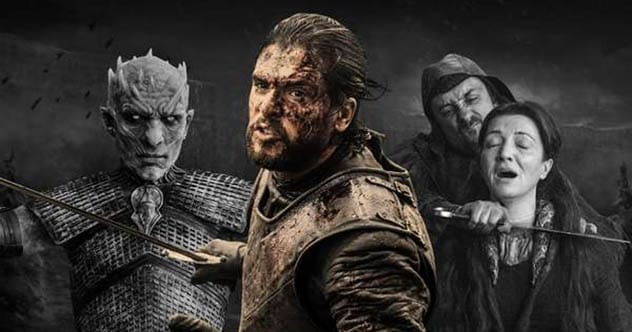With House of the Dragon reviving our love for Westeros, many of us are fondly remembering the wild ride that was Game of Thrones (well, most of it!). Beyond the dragons, dramatic battles, and sharp dialogue, the show hooked us with its grand story and twists no one saw coming.
But, as the saying goes, truth can be stranger than fiction. Many of those jaw-dropping moments in the series were actually inspired by real events from history. Here are 10 of them! But be warned if you’re one of the few who haven’t journeyed through Game of Thrones – spoilers are ahead!
The War of Five Kings / The Wars of the Roses
The main struggle for power in Game of Thrones, known as the War of Five Kings, draws heavily from England’s Wars of the Roses. This real-life conflict raged from 1455 to 1485. Several noble houses fought for the English throne, with the Houses of Lancaster and York being the key rivals. Think Lannister and Stark – see the resemblance?
The despised Joffrey Lannister shares traits with Edward of Lancaster. Edward was known for his cruelty and, like Joffrey, was rumored to be King Henry VI’s illegitimate son. King Henry’s death, much like Robert Baratheon’s, kicked off the Wars of the Roses. Richard, Duke of York, believing the heir wasn’t legitimate, thought he had a stronger claim to the throne.
Margaret of Anjou, King Henry’s wife, is a mirror for Cersei Lannister. Both were involved in affairs, fiercely ambitious, and played a central part in the conflict. Just as Cersei’s actions against Ned Stark fueled the war, Margaret of Anjou openly preparing to attack the Yorks pushed the houses towards battle.
Richard, Duke of York, much like Robb Stark, won early battles but ultimately lost the war. The Wars of the Roses ended when Henry Tudor married Elizabeth of York, uniting the Lancasters and Yorks. A marriage alliance to end the war between Lannisters and Starks didn’t quite happen that way in the show, but let’s not dwell on the series finale…
Jon Snow’s / Julius Caesar’s Assassinations
Remember gasping when Jon Snow, the charismatic leader of the Night’s Watch, was betrayed and killed by his own men? It was a shocking moment, especially since Game of Thrones loved to kill off fan favorites. We’d already mourned Robb Stark, Khal Drogo, and the honorable Ned. Thankfully, Jon didn’t stay dead, but that wait was agonizing!
Jon’s death at the hands of his comrades is strikingly similar to the infamous Ides of March. On that day, Julius Caesar was stabbed to death by members of the Roman Senate. Caesar had risen to become Rome’s ruler and planned to stay in power. He even considered naming himself Emperor, which horrified the Senate. Despite Caesar’s achievements for Rome, many senators disliked his ambition.
Caesar was ambushed and stabbed 23 times. One of his assassins was his adopted son, Brutus, who parallels young Olly in GoT. In Shakespeare’s play, Caesar’s last words, “Et tu, Brute?” (“You too, Brutus?”), echo Jon’s despairing gasp of Olly’s name before the final blow.
The Roman people were horrified by Caesar’s murder and turned against the Senate. His death created a power vacuum, leading to years of civil war. Eventually, Emperor Augustus rose, and Rome became an Empire, making Caesar’s assassination a misguided and ultimately pointless act.
The Red Wedding / The Black Dinner
Few scenes in television history are as horrifying as the Red Wedding. The beloved Starks were brutally massacred at Walder Frey’s castle, ending their quest for vengeance. Game of Thrones had plenty of death, but being murdered by a supposed ally during a feast felt uniquely despicable.
Plus, since Talisa was pregnant and had even chosen a name, it felt like they killed Eddard Stark twice. Just awful.
George R.R. Martin himself confirmed that the Red Wedding was inspired by a historical event: the Black Dinner in medieval Scotland. Sixteen-year-old William, Earl of Douglas, and his younger brother David were invited to dine with ten-year-old King James II. Though James and William were friends, the Black Douglas clan was seen as a threat to the young king’s rule. The dinner was a trap set by Sir William Crichton, the Scottish Chancellor.
During the meal, the Douglas boys were presented with a plate bearing a black bull’s head – a symbol of death for the Black Douglas clan. This symbolic gesture is similar to Robb Stark and his direwolf being beheaded. After this grim presentation, the boys were arrested, put through a mock trial, and executed.
Another event influencing the Red Wedding was the Glencoe Massacre of 1692. In this case, Captain Robert Campbell accepted the hospitality of the MacDonald clan and then murdered his hosts. In both historical events, and at the Red Wedding, the sacred rules of hospitality were violated, adding to the horror.
The Wall / Hadrian’s Wall
One of the most iconic visuals in Game of Thrones (besides the dragons, of course) was the massive ice Wall separating the Seven Kingdoms from the “Wildlings.” This is a direct nod to Hadrian’s Wall, a real 117-kilometer (73-mile) wall built across what is now the United Kingdom.
Emperor Hadrian constructed the wall to protect the Roman province of Britannia from Caledonia (modern-day Scotland). Much like the Wildlings beyond the Wall, the Caledonian tribes were considered lawless and often raided Roman settlements. There was significant tension between the Romans and their northern neighbors, and Hadrian’s Wall was meant to keep them out. Luckily for the Romans, they didn’t have an army of the dead to worry about!
The Dothraki / Mongol Empire
When Daenerys Targaryen marries Khal Drogo, we get a look into the fierce, nomadic lifestyle of the Dothraki. In their culture, strength is everything. They were feared across the land as some of the world’s deadliest warriors, always on horseback.
This is very similar to the Mongol Empire, which dominated much of Asia and Europe in the 13th and 14th centuries. Like the Dothraki, Mongols were skilled horsemen and warriors, constantly on the move. Mongol children learned archery and riding from a young age, a tradition mirrored by the Dothraki, who began training at age four.
The Mongol Empire was founded by the formidable Genghis Khan. He was a renowned warrior and, interestingly, is an ancestor to about 0.5 percent of the world’s current male population. He’s the clear inspiration for Khal Drogo, who was revered as the mightiest Khal of all.
The Battle of Blackwater Bay / The Siege of Constantinople
The Battle of Blackwater Bay was an epic showdown. Fans were likely torn: wanting Stannis to defeat the hated Lannisters, but also rooting for Tyrion, the only truly redeemable Lannister. In the show, Tyrion cleverly uses Wildfire – a devastating substance that burns through stone, steel, wood, and flesh – to outsmart Stannis’s larger forces.
This fiery tactic was likely inspired by the second Arab siege of Constantinople. During this historic battle, the advancing Arab army was defeated by a substance called “Greek Fire.” Like Wildfire, Greek Fire could continue burning even on water. Just as Stannis’s naval fleet was decimated, the attacking Arab fleet was largely destroyed by the flames before they could reach Constantinople’s walls.
To this day, the exact recipe for Greek Fire remains a mystery.
Ramsay Bolton / King Ashurbanipal
One of the most satisfying moments in the series was watching the cruel Joffrey Baratheon meet his gruesome end. If only we knew the horrors of the next villain, we might have preferred Joffrey!
Ramsay Bolton took his house’s sigil – the flayed man – very literally. His sadistic enjoyment of torture was stomach-churning. It’s even more disturbing to know his character has a real-life historical inspiration.
The ancient Assyrians were feared not just for their fighting skills but also for their love of torture. King Ashurbanipal of Assyria was no exception, using torture as a tool of psychological warfare. Besides impalement and crucifixion, Ashurbanipal was known for public flaying to display his power. He would have victims’ skin slowly peeled away, often starting at the legs or buttocks. In a truly grotesque display, he would sometimes hang the flayed skin around his city walls as a warning to anyone who dared disobey. Horrifying.
Joffrey’s / Attila the Hun’s Deaths
Speaking of Joffrey’s death, his demise shares some eerie similarities with that of the infamous Attila the Hun.
Like Joffrey, Attila met his end on his wedding night. While celebrating his marriage to his new wife, Ildico, Attila indulged heavily in alcohol, as one might on such an occasion. Sadly, his celebration was cut short.
He was found dead the next morning under mysterious circumstances, bleeding from his nose and mouth. Accounts vary: some say he suffered internal bleeding due to excessive drinking, while others suggest the intoxicated groom choked to death after a nosebleed. Either way, it paints a picture disturbingly similar to Joffrey’s agonizing final moments.
Jamie Lannister’s / Götz von Berlichingen’s Prosthetic Hands
Jamie Lannister is a complicated character. On one hand, we rooted for the charming Kingslayer to find redemption and become the honorable man Brienne of Tarth saw in him. Who doesn’t love a good redemption arc?
On the other hand, he did push a child out of a window. So, there’s that.
Regardless, Jamie losing his sword hand was a shocking twist, and you couldn’t help but feel for him. Losing a hand is devastating for anyone, but for the renowned swordsman, it was like losing a part of himself. “I was that hand,” he lamented. Upon returning to King’s Landing, Jamie received a golden prosthetic. While very Lannister-esque, it must have been heavy and rather impractical.
Interestingly, his prosthetic hand has historical roots. A German knight named Götz von Berlichingen lost his right hand at age 23 due to enemy cannon fire. Accounts differ on the exact details – one says a cannonball hit his sword, which then severed his arm, while another claims the cannonball took it off directly. Either way, Götz left the battle one hand lighter.
Like Jamie, this was Götz’s fighting hand. He too received a prosthetic, but unlike Jamie’s golden hand, Götz’s was made of iron and had articulated joints. This allowed him to continue fighting! He could use his left hand to tighten the joints of his iron hand, enabling him to grip a sword. Known as “Götz of the Iron Hand,” he fought until age 64 before retiring.
The Lord of Light / Zoroastrianism
“For the night is dark and full of terrors.” The Red Woman, Melisandre, and her “Lord of Light” certainly stirred up conflicting feelings. By the end of the series (however frustratingly executed), it became clear Melisandre had a crucial role. Still, her willingness to burn people alive, including the innocent Princess Shireen, cemented her as a deeply troubling, if not evil, character.
The Lord of Light, known as R’hllor, is a nod to Zoroastrianism, arguably one of the world’s oldest monotheistic religions. Followers of Zoroastrianism worship a single god and hold fire as a sacred symbol. Fire represents light, warmth, and purifying powers. Melisandre and other followers of R’hllor often speak of fire “burning away sins” and consider death by fire to be the “purest death.”
It’s fascinating how many elements of Game of Thrones connect back to real-world history, isn’t it?
History often provides a rich tapestry of drama, conflict, and larger-than-life characters, proving that sometimes the most unbelievable stories are the true ones. Game of Thrones brilliantly wove these historical threads into its own epic narrative, creating a world that felt both fantastical and deeply familiar.
What other historical parallels did you notice in Game of Thrones? Share your thoughts in the comments below!










